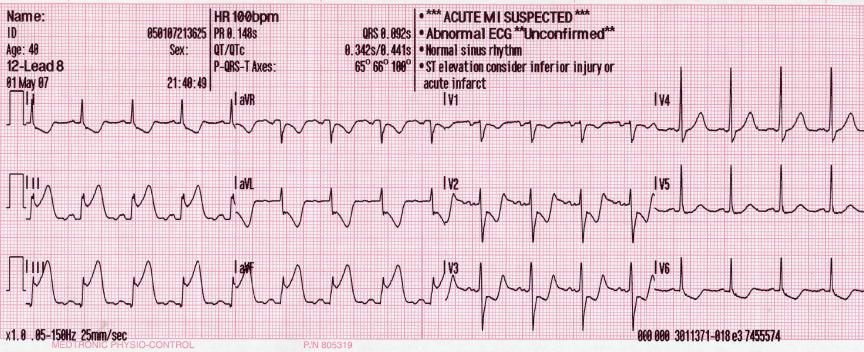[1]
Aydin F,Turgay Yildirim O,Dagtekin E,Huseyinoglu Aydin A,Aksit E, Acute Inferior Myocardial Infarction Caused by Lightning Strike. Prehospital and disaster medicine. 2018 Aug 29
[PubMed PMID: 30156178]
[2]
Lévy S, Bundle branch blocks and/or hemiblocks complicating acute myocardial ischemia or infarction. Journal of interventional cardiac electrophysiology : an international journal of arrhythmias and pacing. 2018 Aug
[PubMed PMID: 30136134]
[3]
Balasubramanian K,Ramachandran B,Subramanian A,Balamurugesan K, Combined ST Elevation in a Case of Acute Myocardial Infarction: How to Identify the Infarct-related Artery? International journal of applied
[PubMed PMID: 30123751]
Level 3 (low-level) evidence
[4]
Bouhuijzen LJ,Stoel MG, Inferior acute myocardial infarction with anterior ST-segment elevations. Netherlands heart journal : monthly journal of the Netherlands Society of Cardiology and the Netherlands Heart Foundation. 2018 Aug 13
[PubMed PMID: 30105594]
[5]
Aguiar Rosa S,Timóteo AT,Ferreira L,Carvalho R,Oliveira M,Cunha P,Viveiros Monteiro A,Portugal G,Almeida Morais L,Daniel P,Cruz Ferreira R, Complete atrioventricular block in acute coronary syndrome: prevalence, characterisation and implication on outcome. European heart journal. Acute cardiovascular care. 2018 Apr
[PubMed PMID: 28617040]
[6]
Roshdy HS,El-Dosouky II,Soliman MH, High-risk inferior myocardial infarction: Can speckle tracking predict proximal right coronary lesions? Clinical cardiology. 2018 Jan
[PubMed PMID: 29377172]
[7]
Albulushi A,Giannopoulos A,Kafkas N,Dragasis S,Pavlides G,Chatzizisis YS, Acute right ventricular myocardial infarction. Expert review of cardiovascular therapy. 2018 Jul
[PubMed PMID: 29902098]
[8]
Albaghdadi A,Teleb M,Porres-Aguilar M,Porres-Munoz M,Marmol-Velez A, The dilemma of refractory hypoxemia after inferior wall myocardial infarction. Proceedings (Baylor University. Medical Center). 2018 Jan
[PubMed PMID: 29686558]
[9]
Sibbing D,Aradi D,Jacobshagen C,Gross L,Trenk D,Geisler T,Orban M,Hadamitzky M,Merkely B,Kiss RG,Komócsi A,Dézsi CA,Holdt L,Felix SB,Parma R,Klopotowski M,Schwinger RHG,Rieber J,Huber K,Neumann FJ,Koltowski L,Mehilli J,Huczek Z,Massberg S, Guided de-escalation of antiplatelet treatment in patients with acute coronary syndrome undergoing percutaneous coronary intervention (TROPICAL-ACS): a randomised, open-label, multicentre trial. Lancet (London, England). 2017 Oct 14
[PubMed PMID: 28855078]
Level 1 (high-level) evidence
[10]
Bahramali E,Askari A,Zakeri H,Farjam M,Dehghan A,Zendehdel K, Fasa Registry on Acute Myocardial Infarction (FaRMI): Feasibility Study and Pilot Phase Results. PloS one. 2016
[PubMed PMID: 27907128]
Level 2 (mid-level) evidence
[11]
Udroiu CA,Cotoban A,Ursulescu A,Siliste C,Vinereanu D, Interdisciplinary Approach in a Complex Case of STEMI. Maedica. 2014 Dec
[PubMed PMID: 25705309]
Level 3 (low-level) evidence
[12]
Martin D,Bekiaris B,Hansen G, Mobile emergency simulation training for rural health providers. Rural and remote health. 2017 Jul-Sep
[PubMed PMID: 29040811]
[13]
Kiani F,Hesabi N,Arbabisarjou A, Assessment of Risk Factors in Patients With Myocardial Infarction. Global journal of health science. 2015 May 28
[PubMed PMID: 26234995]
[14]
Li H,Guo W,Dai W,Li L, Short-versus long-term dual antiplatelet therapy after second-generation drug-eluting stent implantation: a systematic review and meta-analysis of randomized controlled trials. Drug design, development and therapy. 2018
[PubMed PMID: 29970956]
Level 1 (high-level) evidence
[15]
Ginanjar E,Yulianto Y, ST Elevation in Lead aVR and Its Association with Clinical Outcomes. Acta medica Indonesiana. 2017 Oct
[PubMed PMID: 29348386]
Level 2 (mid-level) evidence
[16]
Altıntaş B,Yaylak B,Ede H,Altındağ R,Baysal E,Bilge Ö,Çiftçi H,Adıyaman MŞ,Karahan MZ,Kaya I,Çevik K, Impact of right ventricular diastolic dysfunction on clinical outcomes in inferior STEMI. Herz. 2017 Oct 9
[PubMed PMID: 28993840]
Level 2 (mid-level) evidence


